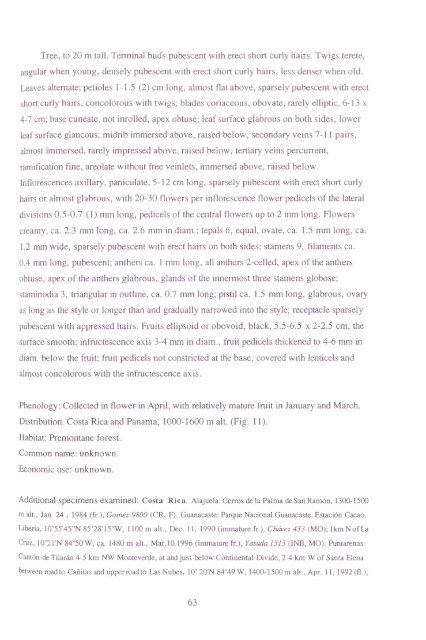Revisional study of neotropical Beilschmiedia species (Lauraceae ...
Revisional study of neotropical Beilschmiedia species (Lauraceae ...
Revisional study of neotropical Beilschmiedia species (Lauraceae ...
You also want an ePaper? Increase the reach of your titles
YUMPU automatically turns print PDFs into web optimized ePapers that Google loves.
Tree, to 20 m tall. Terminal buds pubescent with erect short curly hairs. Twigs terete,<br />
angular when young, densely pubescent with erect short curly hairs, less denser when old.<br />
Leaves alternate; petioles 1-1.5 (2) em long, almost flat above, sparsely pubescent with erect<br />
short curly hairs, concolorous with twigs; blades coriaceous, obovate, rarely elliptic, 6-13 x<br />
4-7 em; base cuneate, not inrolled, apex obtuse; leaf surface glabrous on both sides, lower<br />
leaf surface glaucous; midrib immersed above, raised below, secondary veins 7-11 pairs,<br />
almost immersed, rarely impressed above, raised below, tertiary veins percurrent,<br />
ramification fine, areolate without free veinlets, imn1ersed above, raised below.<br />
Inflorescences axillary, paniculate, 5-12 em long, sparsely pubescent with erect short curly<br />
hairs or almost glabrous, with 20-30 flowers per inflorescence flower pedicels <strong>of</strong> the lateral<br />
divisions 0.5-0.7 (1) mm long, pedicels <strong>of</strong> the central flowers up to 2 mm long. Flowers<br />
creamy, ca. 2.3 mm long, ca. 2.6 mm in diam.; tepals 6, equal, ovate, ca. 1.5 mm long, ca.<br />
1.2 mm wide, sparsely pubescent with erect hairs on both sides; stamens 9, filaments ca.<br />
0.4 mm long, pubescent; anthers ca. 1 mm long, all anthers 2-celled, apex <strong>of</strong> the anthers<br />
obtuse, apex <strong>of</strong> the anthers glabrous, glands <strong>of</strong> the innermost three stamens globose;<br />
staminodia 3, triangular in outline, ca. 0.7 mm long; pistil ca. 1.5 mm long, glabrous, ovary<br />
as long as the style or longer than and gradually narrowed into the style; receptacle sparsely<br />
pubescent with appressed hairs. Fruits ellipsoid or obovoid, black, 5.5-6.5 x 2-2.5 em, the<br />
surface smooth; infructescence axis 3-4 mm in diam., fruit pedicels thickened to 4-6 mm in<br />
diam. below the fruit; fruit pedicels not constricted at the base, covered with lenticels and<br />
almost concolorous with the infructescence axis.<br />
Phenology: Collected in flower in April, with relatively mature fruit in January and March.<br />
Distribution: Costa Rica and Panama, 1000-1600 m alt. (Fig. 11).<br />
Habitat: Pren1ontane forest.<br />
Common name: unknown.<br />
Economic use: unknown.<br />
Additional specimens examined: Costa Rica. Alajuela: Cerros de la Palma de San Ram6n, 1300-1500<br />
malt., Jan. 24, 1984 (fr.), Gomez 9800 (CR, F). Guanacaste: Parque Nacional Guanacaste, Estaci6n Cacao,<br />
Liberia, 10°55'45"N 8Y28'15"W, 1100 m alt., Dec. 11, 1990 (immature fr.), Chavez 433 (MO); 1km N <strong>of</strong> La<br />
Cruz, 10°2 l'N 84°50'W, ca. 1480 malt., Mar.10.1996 (immature fr.), Yasuda 1313 (INB, MO). Puntarenas:<br />
Canton de Tilaran 4-5 km NW Monteverde, at and just below Continental Divide, 2-4 km W <strong>of</strong> Santa Elena<br />
between road to Canitas and upper road to Las Nubes, 10° 20'N 84°49'W, 1400-1500 m alt., Apr. 11, 1992 (fl.),<br />
63
















